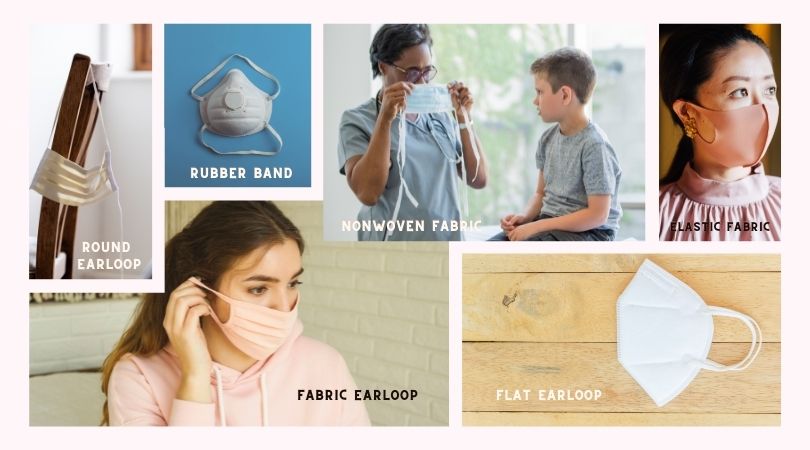There are many types of facemask earloop, but which of them are most comfortable? During the epidemic, you have to wear a mask all the time. But some facemask earloop (earbands) are either too tight or too inflexible and always make the upper edge of the ear hurt and swollen; or the elasticity of earloop is too poor, and the earloop will loosen as soon as you wear it. This article will show you 5 Key points that affect the comfort of mask earloops.
Choose a good “earloop” instead of just a “mask” to make your ears no longer hurt and swollen…
5 Key points that affect the comfort of facemask earloops –
-
Quality of facemask earloop
Facemask earloop is a very important part of a facemask. Just like when wearing glasses, the length, thickness and material of the temples can affect the pressure on our ears, which in turn becomes one of the keys to the comfort of wearing; Same to masks. In the process of selecting a mask, in addition to considering the filtering effect of the meltblown fabric, the comfort of the inner layer of the mask, and the beauty of the outer layer of the mask, the quality of the earloop can be directly related to the quality of a mask. In the era of coexistence with the virus, masks have become an indispensable accessory in everyone’s life. A good earloop is as important as a good mask.
1. Types of facemask earloop
The types of facemask earloops used by each mask factory are slightly different. According to the type, they can be divided into hollow, solid, round, flat, fabric, rubber band or non-woven earloops. Each earloop has its own supporters. Generally, solid flat earloops and round earloops are the two most common earloops. According to different needs and preferences, the main advantages and disadvantages of each earloop are listed as follows:
1.1 Flat earloop: Usually made of man-made fiber, attached to the mask body by welding; delicate appearance, strong, durable, and not easy to loosen under long-term stretching.
1.2 Round earloops: Usually made of man-made fibers, attached to the mask body by welding; poor appearance, soft touch to the skin, less pressure on the face and ears, and more comfortable.
1.3 Fabric earloops: Usually made of pure cotton, blended fabric or man-made fiber material, and attached to the mask body by sewing; they are relatively inelastic.
1.4 Tie-around ear straps: Generally made of non-woven fabrics, this earloop has a strap on each of the four ends of the mask body. When wearing, the upper two non-woven straps are tied back on the upper part of the head. The other two non-woven straps are tied back under the lower part of the head. The advantage is that it can make masks closer to the face than the earloop-type masks, and it is not easy to fall off after being fastened. It is a style used by doctors who need to spend a long time in the surgical operating room.
1.5 Stretchable non-woven ear straps: Generally made of stretchable non-woven fabric material. It needs to be welded on the mask by high frequency welding machine and the output is not high. Because the cost of this kind of ear strap is too high for disposable masks, it is rarely seen in the market.
1.6 Laser cut earloop for 3D mask: Usually made of non-woven fabric or knitted fabric. This 3D mask is produced by mold punching or laser cut; the advantage is that there is no welding joint on the mask so the earloops will not fall off due to poor welding. 3D mask is comfortable and soft and will not cause ear pain from wearing a mask for a long time; but the disadvantage is that the 3D mask is not suitable for certain face shapes or people who wear glasses.
1.7 Rubber band: Usually made of natural rubber or synthetic rubber, which is different from the above-mentioned earloops or tie-around ear straps. The rubber bands are attached on the two sides of the masks. When wearing, the lower rubber band need to be pulled over the top of the head to the back of the neck position under the two ears, and the upper rubber band should be pulled back to the top of the head. The rubber bands are usually used on a cup-shaped N95 mask, which can make the mask fit the face more closely without any gaps. Because the rubber bands are too tight, it is easy to make your face pain or red after wearing the mask for a long time. Rubber band is mainly used for medical or industrial N95 masks.
1.8 Elastic band: Usually made of man-made fiber. It is a substitute for rubber band and is mostly used in N95 or KN95. Due to the material of the elastic band, it cannot be attached with the non-woven fabric by welding, so it cannot be used for disposable non-woven masks.
Reminder: Every mask and earloop has its own supporter. If you want to find out the most suitable mask and earloop for you, we recommend you to test the mask first!

<Types of facemask earloop>
2. Materials of facemask earloop
Round earloop is recommended for disposable facemask because it’s most suitable and comfortable. The diameter of round earloop is about 2.8-3.2mm. Some masks are using flat earloops with a diameter of 4mm-5mm. You can see all kinds of masks and earloops on the market now.
The most common materials of earloops are:
*Nylon and elastic fiber (Spandex), or
*Polyester and elastic fiber (Spandex)
Nylon, polyester, and elastic fiber are all man-made fibers, odorless and non-fluorescent. They are very suitable materials for making facemask earloops because earloops have direct contact with people’s face and ears. Nylon is softer and more elastic than polyester fiber. Although the technology is getting more and more advanced nowadays, the handfeel of polyester fiber is getting closer and closer to nylon, but nylon is still the major material for making earloop because it has a smooth hand feel, strong and durable. When purchasing mask earloops, you can choose the yarn size, adjust the knitting density or the diameter of earloops according to your needs.
Natural fiber earloops are using cotton and linen, or new materials such as corn fiber and bamboo fiber. The advantage of using natural fiber to make earloop is that it absorbs moisture and keeps wearer warm, but its fiber is easy to fall off and easy to have bacteria when wearing the mask for a long time. Natural fiber is not suitable for medical masks; it’s mostly used for home-made fabric masks.
The material of tie-around earloop is the same as the outer layer of the mask (PPSB). The PPSB non-woven fabric has the property of water repellent, which can prevent the earloop from getting wet by sweat during long-term surgical operations; compared with ordinary earloops, tie-around earloops made of non-woven fabrics are usually wider.
Rubber band can be made by either natural rubber or synthetic rubber. However, natural rubber is not suitable for people who are allergic to it, so currently most N95 masks are using synthetic rubber band. Users with allergic concerns can choose products with “Latex-Free” certification.
3. Length of facemask earloop
The length of earloops varies slightly according to the manufacturing process of each mask factory. Generally, the length of earloops for adult’s masks is between 14 cm and 18 cm, and the length of earloops for children’s masks is 14 ± 0.5 cm. it’s hard to find the most suitable length of the earloops because the wearers’ heads and faces are in different sizes and shapes. The length of the earloops of adult’s masks is still recommended to be 18cm to cover wearers’ noses and mouths completely.
If the earloop length of the bulk masks supplied in the market does not meet your own needs, you can consider buying a more flexible tie-around mask. There are also many facemask adjuster in the market today to solve the discomfort caused by the length of the earloop, such as velcro tape attached with elastic band, mask adjustment buckle, or adding foams to the ears. You can try various ways to adjust the earloop length as long as you don’t affect the filtering efficiency of the mask body!
4. Colors of facemask earloop
The most common color of earloop is white. However, due to the long lasting of epidemic, more and more mask factories have begun to produce customized and printed masks. Therefore, there is also a demand for colored earloops in order to match the color of the mask. When purchasing colored earloops, pay attention to some chemical substances it might contain, such as formaldehyde and migratory fluorescent agents. People with sensitive skin can request for related certificates from mask factory (e.g. skin irritation reports and cytotoxicity reports). Basically white is still the safest and most popular color at present.

< Colored facemask earloop>
5. Facemask earloop elasticity and test method
After understanding the differences of various earloops, the most important thing is to choose the right type of earloops to make a mask. There are two key factors that affect whether the earloops can make the wearer feel comfortable and whether it can last all day:
- Earloop elongation: Elongation refers to the elasticity of the earloop itself, that is, the maximum stretchable length. If the stretch rate is not large enough, the earloops will be too tight when wearer pulls the bands behind the ears, which will put a lot of pressure on the ears, and will make the wearer feel hurt and uncomfortable. Generally, the stretch rate of the earloops is ≧280%-290% (elasticity ratio 1: 2.8-2.9) as the standard.
- Earloop rebound rate: Rebound rate refers to the rebound ability of the earloop, that is, the ability to return to a certain range of the original length after being stretched by an external force for a period of time. If the rebound rate is too large, the earloops of the mask will become looser after a long period of time, and the mask can’t provide complete protection to the wearer. Generally, the rebound rate of earloops is required to be ≦ 120% as the standard.
If you want to know whether the masks you wear meet the standards, besides asking for relevant certificates from the manufacturers, you may also test the earloops at home by following the simple steps below.
3 steps to test your earloop!
- Take a ruler, cut 10cm earloops and put it on the edge of the ruler and pinch the left and right ends. If you don’t have a scissor, you may also just use a pen or marker to mark 10cm length.

< Step 1 >
- Test the tensile elasticity: fix the left end at 0cm, pinch the 10cm end on the right side and extend it to the maximum (note: do not move the pinch position). If it can be stretched to more than 28cm, it means its elasticity is ≧280%-290%.

<Step 2>
- Test rebound rate: stop at step 2 for about 1 minute, slowly release the force to retract to the left. If the earloops can return to within 12cm, it means the rebound rate is ≦120%.

<Step 3>
Finally, we recommend that after using the mask, wrap the earloop of the mask around the mask and put it in the trash can after tying it tightly to avoid the earloop accidentally tangling the mouth of cats and dogs, or falling into the sea to entangle the seabed creatures. Let us protect animals and environmental hygiene together!

The above is just brief introduction and test methods of earloops. If you have any other questions, please feel free to contact us for consultation!
~The end~

